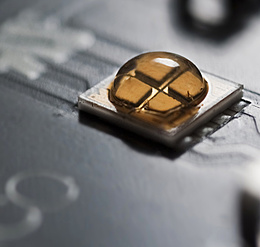Light colour is the colour of the light emitted by a lamp. Light colour can be expressed using x,y coordinates as chromacity coordinates in a standard colorimetric system, or, for white light colours, it can also be given as the colour temperature TF . In the CIE standard colorimetric system, the colour of light is calculated from the spectral constitution and represented in a continuous, two-dimensional diagram. The hue is defined via the chromaticity co-ordinates of the spectral colour and via the saturation level. The design of the diagram features a coloured area that contains every possible real colour. The coloured area is encompassed by a curve on which the chromaticity locations of the completely saturated spectral colours lie. At the centre of the area is the point of least saturation, which is designated as a white or uncoloured point. All levels of saturation of one colour can now be found on the straight lines between the uncoloured point and the chromaticity location in question. Similarly, all mixtures of two colours are likewise to be found on a straight line between the two chromaticity locations in question.




































